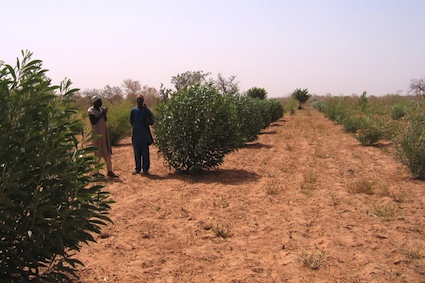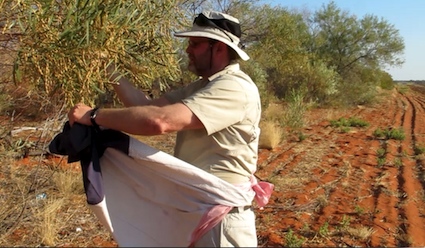Australian acacia trees have vast, untapped potential as multi-purpose trees in semi-arid regions where people are vulnerable to hunger and famine.
The Acacia Tree Project has continued over the last 30 years, particularly in Niger and Australia, with a focus on species selection, crop testing, food and cooking trials.
Niger is within the Sahel region of Africa: home to some of the poorest people in the world, where the land is turning to desert. People there are very vulnerable to famine as they are dependent on the four monsoon months of rain each year for food. Some years there is not enough rain and there is famine.

Farmers with acacia crops in Niger
Over the last three decades, a group of development workers, scientists, African farmers and Australian aboriginal people have recognised that planting Australian acacia trees offers the best way of regenerating the land and restoring livelihoods.
Australian acacia trees grow in Australian desert regions so they are suited to the semi-arid conditions of the Sahel. They are a pioneer species, that is, they can grow quickly where there is nothing else but a bleak, desert landscape and create an environment for other plant and tree species to follow.

Acacia expert Peter Cunningham collecting seeds for the Sahel in the Australian desert
Pioneering Australian acacia trees create a living shelter by capturing moisture and providing windbreaks and shade. The trees restore the soil: the roots bind the land and the leaves fall and turn to fertilising mulch. Animals, birds and insects can return.
Australian acacia trees provide wood, which is frequently the only available fuel source in the Sahel, so it is valuable to use or sell.
The timber of Australian Acacias is strong and can also be used as a building material.
The leaves and seeds of the trees provide food for livestock.
Perhaps most importantly, the seeds of certain types of Acacia trees could provide a nutritious source of food. Australian aboriginal people have eaten the seeds of around 40 types of acacia trees for thousands of years. In some villages in Niger, people have eaten one particular species, Acacia colei, for around 28 years. The seeds are harvested, de-husked, roasted and ground to a flour or paste for use in traditional recipes.
Five types of Acacia seeds, selected for their potential to provide food as well as optimal crops in the Sahel, including Acacia colei, are undergoing an extensive food trial process in Australia in order to formally approve the seeds as a food source.
While there have been no problems over the past 30 years with weediness of acacias in the Sahel region, an expert in acacia agriculture with over 20 years experience with acacias in Niger and more recently, Ethiopia, is developing weediness protocols specific to Sahel conditions.
Extensive, formal research is underway in Melbourne, Australia, into the suitability of certain types of acacia seeds as food with leading technical organisations including The University of Melbourne and the Florey Institute.
The Acacia Tree Project is also building awareness of how Australian acacia trees can bring multiple benefits to the rural poor of Sahel, Africa.
